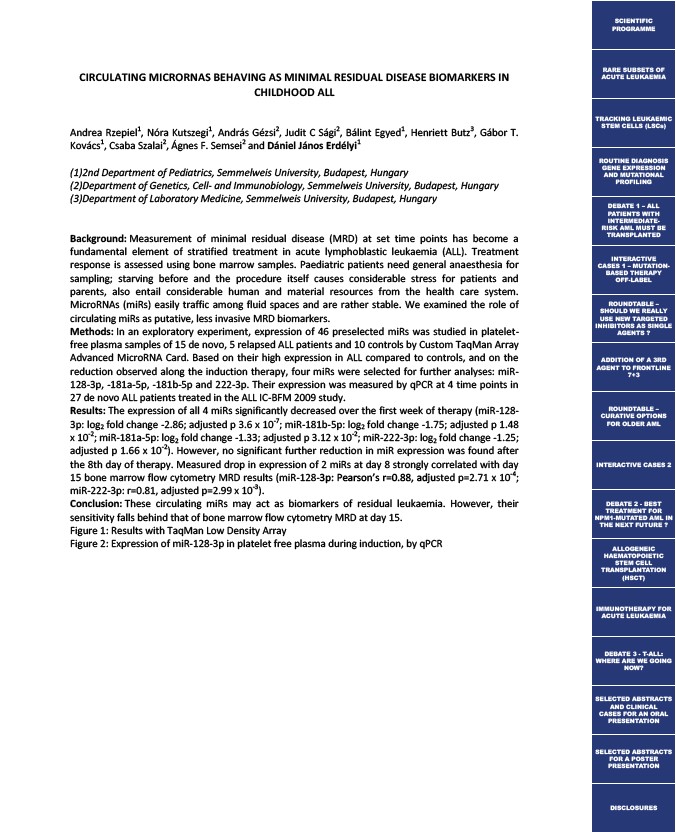
CIRCULATING MICRORNAS BEHAVING AS MINIMAL RESIDUAL DISEASE BIOMARKERS IN
CHILDHOOD ALL
Andrea Rzepiel1, Nóra Kutszegi1, András Gézsi2, Judit C Sági2, Bálint Egyed1, Henriett Butz3, Gábor T.
Kovács1, Csaba Szalai2, Ágnes F. Semsei2 and Dániel János Erdélyi1
(1)2nd Department of Pediatrics, Semmelweis University, Budapest, Hungary
(2)Department of Genetics, Cell- and Immunobiology, Semmelweis University, Budapest, Hungary
(3)Department of Laboratory Medicine, Semmelweis University, Budapest, Hungary
Background: Measurement of minimal residual disease (MRD) at set time points has become a
fundamental element of stratified treatment in acute lymphoblastic leukaemia (ALL). Treatment
response is assessed using bone marrow samples. Paediatric patients need general anaesthesia for
sampling; starving before and the procedure itself causes considerable stress for patients and
parents, also entail considerable human and material resources from the health care system.
MicroRNAs (miRs) easily traffic among fluid spaces and are rather stable. We examined the role of
circulating miRs as putative, less invasive MRD biomarkers.
Methods: In an exploratory experiment, expression of 46 preselected miRs was studied in platelet-free
plasma samples of 15 de novo, 5 relapsed ALL patients and 10 controls by Custom TaqMan Array
Advanced MicroRNA Card. Based on their high expression in ALL compared to controls, and on the
reduction observed along the induction therapy, four miRs were selected for further analyses: miR-
128-3p, -181a-5p, -181b-5p and 222-3p. Their expression was measured by qPCR at 4 time points in
27 de novo ALL patients treated in the ALL IC-BFM 2009 study.
Results: The expression of all 4 miRs significantly decreased over the first week of therapy (miR-128-
3p: log2 fold change -2.86; adjusted p 3.6 x 10-7; miR-181b-5p: log2 fold change -1.75; adjusted p 1.48
x 10-2; miR-181a-5p: log2 fold change -1.33; adjusted p 3.12 x 10-2; miR-222-3p: log2 fold change -1.25;
adjusted p 1.66 x 10-2). However, no significant further reduction in miR expression was found after
the 8th day of therapy. Measured drop in expression of 2 miRs at day 8 strongly correlated with day
15 bone marrow flow cytometry MRD results (miR-128-3p: Pearson’s r=0.88, adjusted p=2.71 x 10-4;
miR-222-3p: r=0.81, adjusted p=2.99 x 10-3).
Conclusion: These circulating miRs may act as biomarkers of residual leukaemia. However, their
sensitivity falls behind that of bone marrow flow cytometry MRD at day 15.
Figure 1: Results with TaqMan Low Density Array
Figure 2: Expression of miR-128-3p in platelet free plasma during induction, by qPCR
SCIENTIFIC
PROGRAMME
RARE SUBSETS OF
ACUTE LEUKAEMIA
TRACKING LEUKAEMIC
STEM CELLS (LSCs)
ROUTINE DIAGNOSIS
GENE EXPRESSION
AND MUTATIONAL
PROFILING
DEBATE 1 – ALL
PATIENTS WITH
INTERMEDIATE-RISK
AML MUST BE
TRANSPLANTED
INTERACTIVE
CASES 1 – MUTATION-BASED
THERAPY
OFF-LABEL
ROUNDTABLE –
SHOULD WE REALLY
USE NEW TARGETED
INHIBITORS AS SINGLE
AGENTS ?
ADDITION OF A 3RD
AGENT TO FRONTLINE
7+3
ROUNDTABLE –
CURATIVE OPTIONS
FOR OLDER AML
INTERACTIVE CASES 2
DEBATE 2 - BEST
TREATMENT FOR
NPM1-MUTATED AML IN
THE NEXT FUTURE ?
ALLOGENEIC
HAEMATOPOIETIC
STEM CELL
TRANSPLANTATION
(HSCT)
IMMUNOTHERAPY FOR
ACUTE LEUKAEMIA
DEBATE 3 - T-ALL:
WHERE ARE WE GOING
NOW?
SELECTED ABSTRACTS
AND CLINICAL
CASES FOR AN ORAL
PRESENTATION
SELECTED ABSTRACTS
FOR A POSTER
PRESENTATION
DISCLOSURES